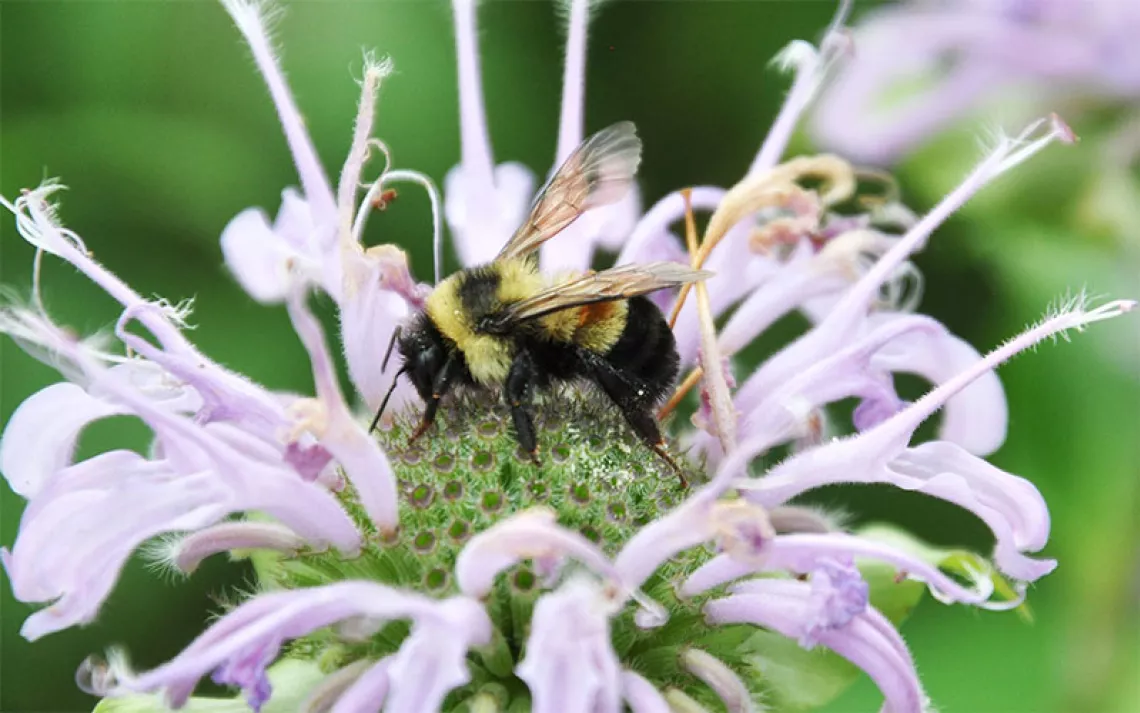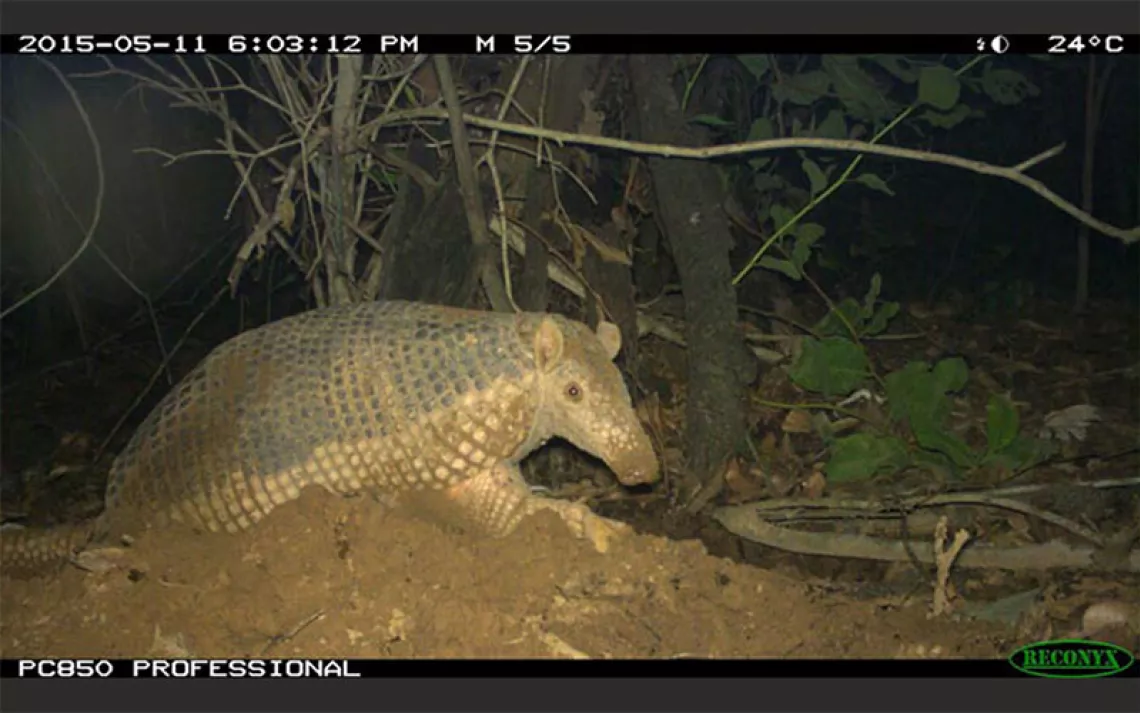Scientists Race to Find Out Why the Western Bumblebee Is Disappearing
Bombus occidentalis was common across the West, but since the 1990s its numbers have plummeted
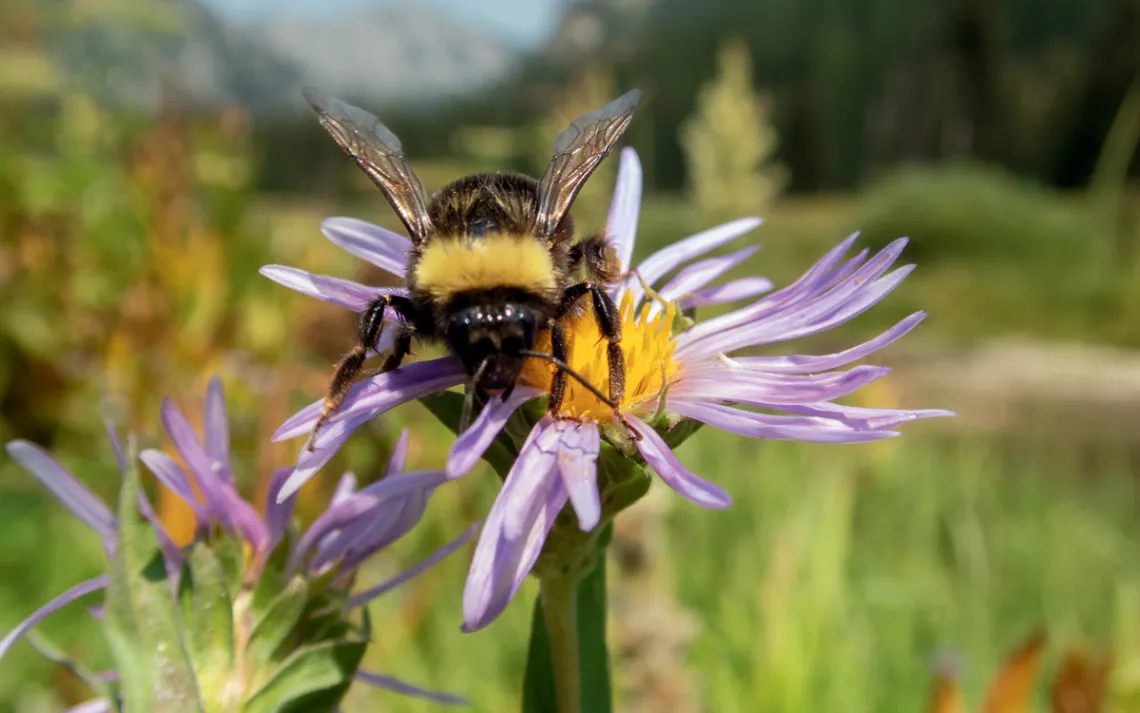
A western bumblebee collects aster pollen. | Photo by Rich Hatfield/the Xerces Society
Ashley Mertens dropped the long handle of her insect net into the grass and used her palms to scoop a slow-moving bumblebee, dazed by the morning chill, off the ground. "You want help, ma'am?" the research technician cooed. She crouched among purple spikes of penstemon and dwarf lupine and held the bee up toward the flowers.
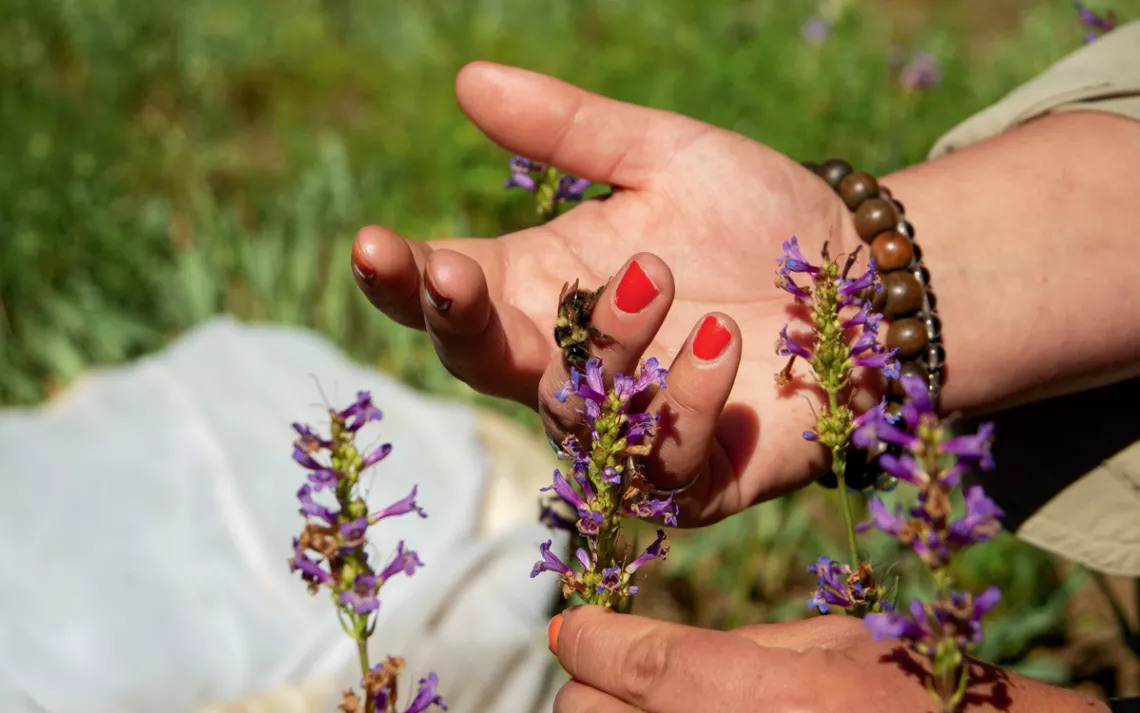
Ashley Mertens holds a fuzzy-horned bumblebee up to a penstemon. | Photo by Sarah Trent
Around her, in a meadow facing the rocky spine of Oregon's Mt. Washington, Mertens's colleagues played with their own bumblebees—a moment of levity on a mission to understand why some species are declining. Jessie Roughgarden, a Utah State graduate student, plucked a penstemon stem with a tiny two-form bumblebee—Bombus bifarius—clinging to its blossoms. Molly Martin, a biologist at the Xerces Society for Invertebrate Conservation, nudged a queen of the same species into a vial. Pauline Peterson, another technician, tried to ID a male, then set off in search of the rarer species this team was looking for, and that I'd come to see: Bombus occidentalis, the western bumblebee.
A year before, during summer 2022, a biologist from Oregon State had stumbled upon a western bumblebee nest near this meadow. It was an extremely rare find that this team—organized by the Xerces Society and the wildlife agencies of Washington and Idaho—was hoping to repeat more intentionally.
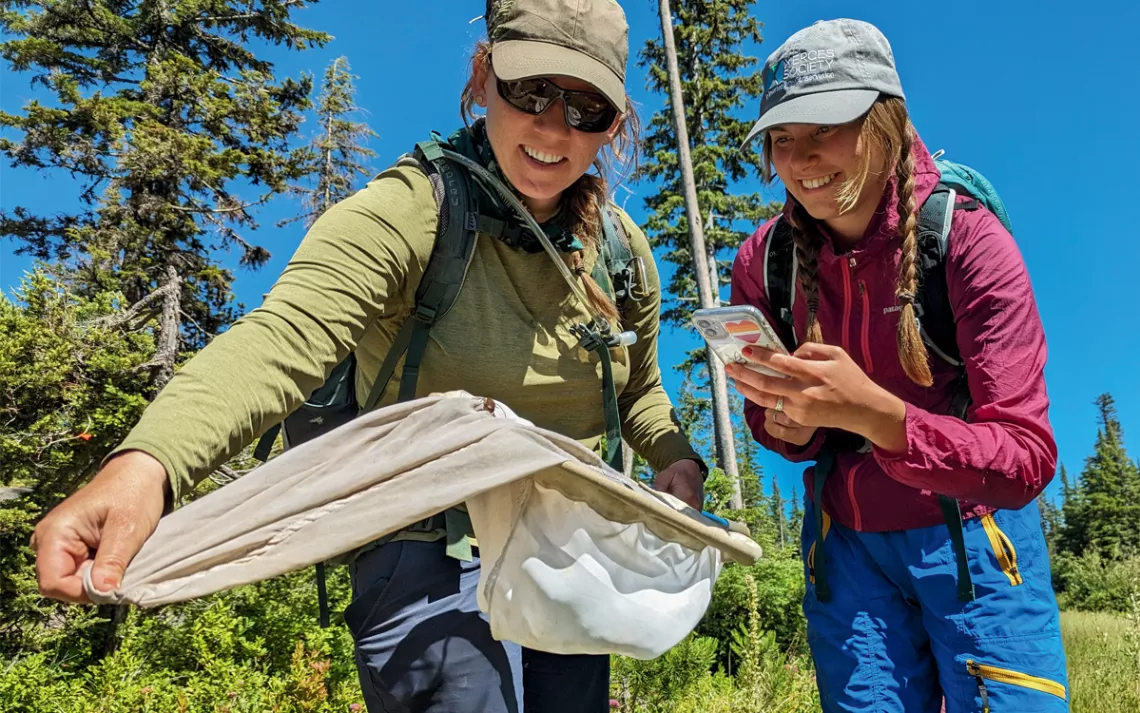
Jessie Roughgarden (left) and Pauline Peterson catch a beetle while searching for bumblebee nests. | Photo by Sarah Trent
Just decades ago, Bombus occidentalis was common across the West, the bees' unmistakable white rumps appearing in alpine meadows and city parks from New Mexico to Alaska. Since the 1990s, their numbers have plummeted, likely due to habitat loss from human development, habitat and seasonal mismatches caused by climate change, and a fungal pathogen, Nosema bombi, spread by commercial bees. Though the decline of honeybees has garnered more attention, the plight of bumblebees is just as concerning: Bumblebees are better pollinators—in part because their buzzing releases more pollen. Whole ecosystems and the creatures that rely on them, including humans, depend on the survival of bumblebees. Federal officials are currently considering listing several species, including the western, as endangered. But scientists don't know enough about them to truly protect these species.
Bumblebees' foraging preferences are among the few things scientists do know about them, so conservation typically involves planting. "But it's possible that flowers aren't the problem," Rich Hatfield, a Xerces Society biologist and the lead researcher on this project, told me. It could be a lack of nesting habitat or problems wherever queens overwinter. Scientists know little about where western bumblebees spend these parts of their lives, except that, as with most bumblebee species, it can be miles from where they forage, and even underground.
So during the summer of 2023, Hatfield's team searched the forested edges of alpine meadows like this one in Oregon, similar to where the few documented western nests have been found. By understanding the bees' nest habits and habitats—what types of holes they use, what food and threats are nearby—scientists, state agencies, and the US Fish and Wildlife Service hope to devise targeted methods to slow or reverse their decline.
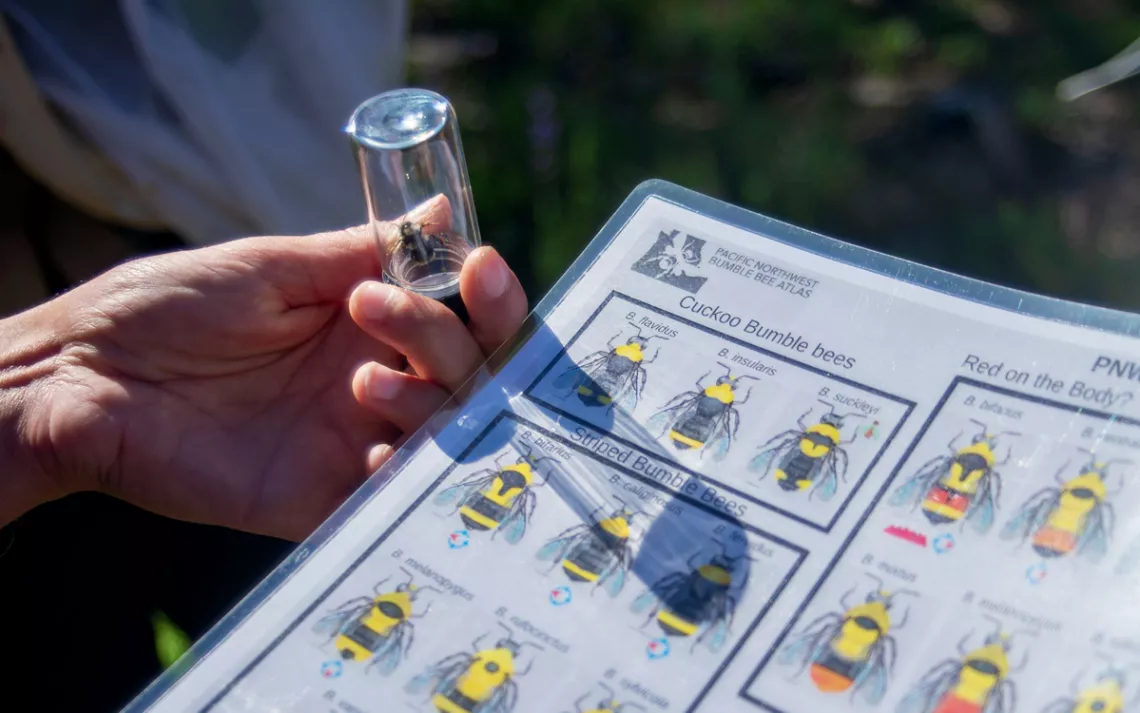
Molly Martin checks a bee against an identification chart. | Photo by Sarah Trent
When I arrived, the team was two weeks into a two-month search. That mid-July morning, we began in earnest near the parking lot of a Forest Service staging area, where campers and their dogs putzed around RVs, while four-wheelers whined along dusty trails. A swale of blooming pink spirea dipped between the road and a rocky slope of conifers. "Here's another western!" Martin called out. "This really seems like a hot spot." The slope above, the team agreed, would be a great place to look for nests.
When bumblebees forage, they do their namesake dance between blooms, rubbing pollen onto what look like heavier and heavier saddlebags. When their pockets—called corbiculae—are full, they zoom horizontally, presumably straight toward their nest. There, they drop toward the entrance and later pop straight up out of it. It's those fast directional flights and vertical comings and goings that this team has learned to look for—the only clues they have, however unreliable. "With our meager human senses, it still feels like we've brought a knife to a gunfight," Roughgarden said.
When this team had started their daily surveys, they hiked fast. Then Roughgarden spotted a nest of the abundant, yellow-faced bumblebee, Bombus vosnesenskii, and saw that minutes could pass without any bee activity. The team had to slow down. They tried following bees from flower to flower, honing in on those with the fullest, ready-to-unload pockets. They tried tying feathers to common species after dazing them on ice, to see if that made the bees easier to follow. Later in the summer, they tested tiny radio-telemetry tags, which have been used to track larger insects. Roughgarden hopes that someday, AI might help too.
The day of my visit, they had decided on a grid search. I followed Roughgarden, eyes peeled, as the team fanned out to climb the fallen-conifer-strewn slope. After 20 minutes, Martin cried out, "I found a nest!" We all clambered over to her, where bees zoomed into the grass below a gnarl of mountain hemlock. These were two-forms, not westerns, but finding any nest is rare, so for 45 minutes we watched. The bees flew in. Then up. Then vanished.
Over the coming weeks, the team would sit there repeatedly, ultimately deciding this was not a nest but a sort of "highway" they don't understand yet. "This research is a lot of collecting the data and then thinking about questions," Martin said. Usually, research works the other way around, but with under-studied creatures, scientists don't always know what to ask. They must see something new first.
Two weeks later, Hatfield emailed to invite me back: The crew had finally found a western nest—and two other species' as well. Each a step toward improving conservation.
When I returned, spirea and penstemon had given way to goldenrod, aster, and lousewort. Hatfield and two Fish and Wildlife biologists came too. We walked up a four-wheeler track, not far from our search area two weeks before, into a messy but open area that had been logged a few years before. "It's right on the other side of that felled log," Mertens told the group, pointing toward a nearly invisible hollow in the sticks and duff. As we watched, a bee strutted out and took flight, flashing its white rear on its way down the hill.
Mertens had found it, like every nest before it, by chance: She'd stopped for a break, and a bee had zipped out past her face. But just finding it was progress.
Soon, search dogs would come to learn the nest's scent, in a bid to find more. Later, after the bees abandoned their nest, Hatfield would peer inside using an endoscope. If the previous, Oregon State–found nest was any indication, this tunnel might run several meters to a hollow containing hundreds of waxy cells built to store food and rear young. Or it might show something entirely new.
But that day, to our meager human senses, it looked like almost nothing. Like twigs, leaves, and a barely registered opening below a single leaning huckleberry stem—until a bee zoomed in, slowing like an airplane rounding a runway, then dropped to the entrance, crawling down into the soil.
Explore
Take a Sierra Club trip to Oregon. For details, see sc.org/outings.
More
In the inaugural year of the Bumble Bee Atlas, over 1,800 bees were recorded. Read about the community scientists' findings: sc.org/bee-atlas.
Do Your Part
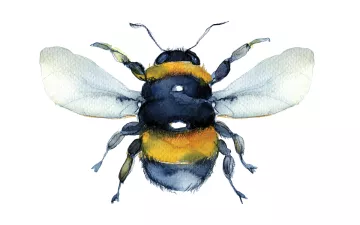
Volunteer to find bumblebees
There aren't enough field biologists to capture the data conservationists need. Volunteer for regional Bumble Bee Atlas surveys run by the Xerces Society and its partners, or download the Bumble Bee Watch app to submit sightings.
Plant early- and late-blooming flowers
In early spring and fall, bumblebee queens need all the food they can get. Queens are the only bumblebees that survive the winter, and without them, future generations won't exist.
Let dandelions and brush piles stick around
Many "weeds" give bees important spring food sources, and "messy" piles of rock or brush may provide valuable backyard nesting habitat.
Don't search for nests—or disturb any you come across
Bumblebee nests can be sensitive as well as hard to find, so it's best to leave them to the experts.
 The Magazine of The Sierra Club
The Magazine of The Sierra Club


